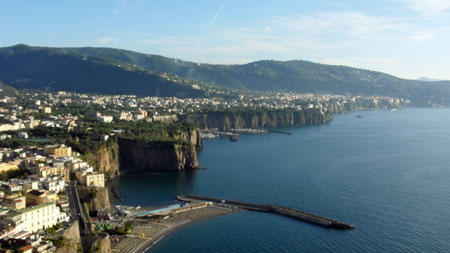After a nice train ride, all the way to Milazzo, the best port to ship to Vulcano for our 7 day stay in Judy’s RCI Resort, booked through Shell Vacations Club, named Bahia Fenicia, closer to Vulcanello (small volcano) than the main Volcano. It was a smooth trip, with door-to-door service from the office in town. A tiny studio/condo, but fine for relaxation.
The next morning, Judy and I decided to climb to the top of the volcano (named Gran Crater). Reading the helpful sign along the road to the start of the climb, the sign said it was a Class 1 climb, EASY to do and you should get there and back in 1 hour and 45 minutes.
httpv://www.youtube.com/watch?v=MojHxonEA40
Several things are wrong here, for example, I am not a mountain climber. If I want to see the top of a mountain, I look at a satellite map on Google. Second, when they say a Class 1 climb, I expect at least an escalator not a steep gravelly path almost straight up the mountain. I also advise you not to wear a pair of open toed sandals since the gravel kept getting into the bottom of my feet. PAIN to walk on! The gravel was small. However, as I climbed, I noticed that the gravel between the bottom of my feet and my shoe seem to increase proportionally to the number of steps I took. Soon, I thought the gravel had increased to some outrageous size that exceeded any other rock on the mountain. However, looking back, I’m sure that’s not true.
We started up the “easy Class 1 climb”, managing to go about 200 to 300 feet at a time before we had to stop to catch our breath and rest. Half way up, Judy started shaking, even while resting but after a brief rest and a drink of water, and some reassurance from a Swedish couple who spoke English, she was fine the rest of the way. Finally we came to some harder rock and the climb got better.
The climb to the top was well worth it, since the volcano is still spewing gases with a strong sulfur smell. The view of the gases, along with the sulfur color and deep crater inside the volcano made the climb worthwhile.
“It is difficult to imagine, and even more difficult to explain, how you feel on a narrow path, with a view to the sea and islands on one side, and on the other the heart of a living mountain, colored with sulphur and giving off steam, heat and hisses. The awareness that, in the past, forces of nature capable of changing the shape of the landscape have broken out from the crater makes you respect and fear this place pulsating with life.” (Dr Franco Italiano, Vulcanologist)
In fact, a large portion of the island smells like sulfur, since there are sulfur dioxide emissions throughout the island and numerous hot springs. Finally, I would like to reclassify this posted Class 1 climb as a local Sicilian (or Vulcanian) joke against the tourists.
More of the Eolian Islands tomorrow!
